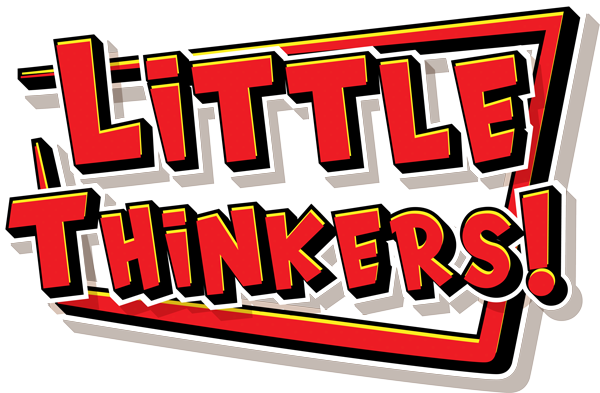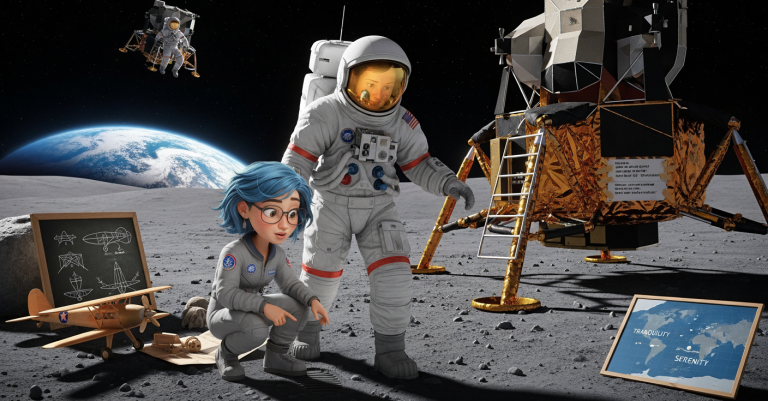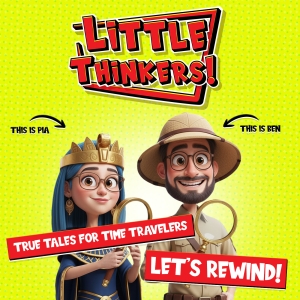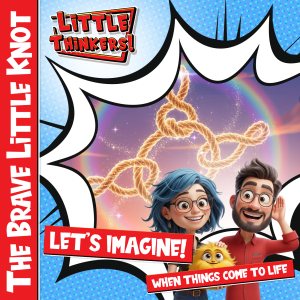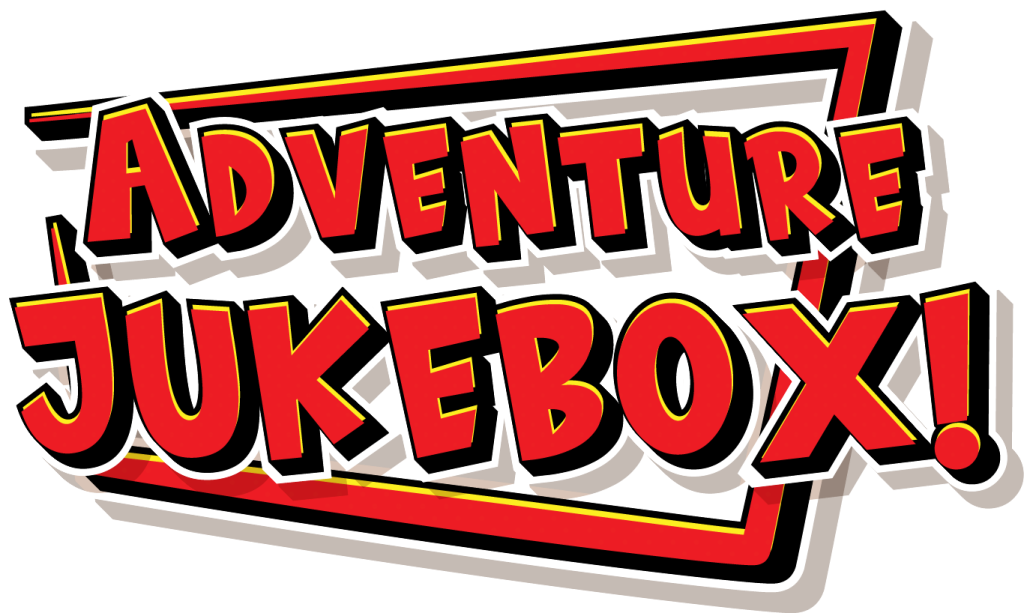The Quiet Boy Who Touched the Moon
Imagine This Amazing Story
Picture a small town in Ohio where crickets chirp on summer evenings. A shy boy sits in his garage, carefully building a tiny airplane from balsa wood. His fingers smell like glue, and his eyes shine with wonder as he watches his creation glide across the yard. That quiet boy was Neil Armstrong, and his gentle hands would one day make the most famous footprint in history!
This is the incredible story of how a modest child who loved model planes became the first human being to walk on the Moon. It’s not just about rockets and space suits – it’s about curiosity, careful work, and staying calm when everything depends on you.
A Boy Who Loved the Sky
In 1936, six-year-old Neil Armstrong lived in Wapakoneta, Ohio, a small farming town where everyone knew everyone. Unlike other kids who might have been loud or always seeking attention, Neil was different. He was quiet, thoughtful, and absolutely fascinated by anything that could fly.
Every time a Ford Trimotor airplane droned overhead, Neil would stop whatever he was doing and look up. The silver plane would tilt and climb through the clouds, and Neil felt something magical in his chest – like the airplane was calling to him. He didn’t just want to watch planes; he wanted to understand how they worked.
Fun Fact!
Neil built his first model airplane when he was just eight years old! He would spend hours in the garage, reading instructions twice to make sure he got everything right. He sanded the wings until they were perfectly smooth because he knew that every tiny detail mattered for flight.
While other kids played with toy cars or baseball cards, Neil collected airplane models and aviation magazines. He studied pictures of wings and propellers like they were treasure maps. His questions never stopped: How do wings create lift? Why does air push back against moving objects? What makes some planes fly faster than others?
Learning to Fly Before Learning to Drive
Here’s something amazing: Neil earned his student pilot license when he was only 16 years old – before he even had a driver’s license! How did a teenager from a small town manage to learn to fly?
Neil worked incredibly hard for his dream. He mowed lawns, delivered newspapers, and did odd jobs around town to save money for flying lessons. Every dollar he earned went toward his goal. On cold winter mornings, you could find him in the garage, breath making little clouds as he worked on model planes and studied aviation books.
The local airfield was tiny – just a grass strip with a small hangar. But to Neil, it was as exciting as a space station! When his flight instructor finally nodded and said, “Let’s take her up,” Neil’s heart raced. The little trainer airplane bumped along the grass runway, then suddenly lifted into the air.
What Was It Like to Fly in 1947?
Flying back then was very different from today! There were no computers or fancy navigation systems. Pilots used simple instruments and had to rely on their skills and knowledge. The planes were smaller, louder, and you could feel every bump and gust of wind. But for Neil, it was pure magic.
From up in the sky, houses looked like tiny toy blocks, and roads became thin gray ribbons stretching across green fields. Neil wasn’t just enjoying the view – he was learning. He took careful notes about everything: how the controls felt, how the wind affected the plane, what happened when he moved the stick or pressed the pedals.
College, War, and Real Challenges
After high school, Neil went to Purdue University to study aeronautical engineering. But after just two years, something big interrupted his education: the Korean War. The U.S. Navy needed pilots, and Neil was called to serve his country.
Navy flight training was much tougher than anything Neil had experienced. He had to learn to land on aircraft carriers – imagine trying to land a plane on a moving ship in the middle of the ocean! The flight deck was like a restless animal, rising and falling with the waves. Neil had to watch special lights that told him if he was coming in too high or too low, adjust his speed perfectly, and catch a cable with a hook under his plane.
When the cable caught his plane, it stopped so suddenly that Neil felt like he was being thrown forward in his seat. But he learned to keep his voice calm and his hands steady, no matter how scary things got.
A Close Call That Changed Everything
One day over Korea, something terrifying happened that showed Neil’s incredible calmness under pressure. He was flying an F-9F Panther jet on a low mission when his wing hit a cable that enemy forces had stretched across a valley. The impact tore his wing and damaged his plane badly.
Most people would panic in a situation like this, but not Neil. His training took over. He knew the plane couldn’t make it back to the aircraft carrier, so he flew toward friendly territory. When he realized the jet was going to crash, he pulled the ejection handle.
BOOM! The ejection seat blasted him out of the cockpit. Wind tore at his body as he fell through the sky, then his parachute opened with a sharp jerk that probably saved his life. He landed in a field, dusty but alive, and calmly walked back to safety.
Instead of bragging about his narrow escape, Neil wrote a clear, detailed report about what happened. He understood that other pilots could learn from his experience, and that’s what mattered most to him.
Becoming a Test Pilot
After the war, Neil finished his engineering degree and got an exciting job with NACA (which later became NASA). He was sent to Edwards Air Force Base in California, where test pilots flew experimental aircraft that pushed the boundaries of flight.
The Mojave Desert around Edwards was perfect for testing – wide, flat, and mostly empty. If something went wrong with an experimental plane, there was plenty of safe space to make an emergency landing on the dry lake bed.
Neil wasn’t just a pilot anymore; he was also an engineer. This meant he understood both how to fly planes and how they were built. Before each test flight, he would study thick manuals, talk with the engineers who built the aircraft, and plan exactly what he would test and measure.
The Rocket Plane That Touched Space
One of the most amazing planes Neil flew was called the X-15. This wasn’t a regular airplane – it was more like a rocket with wings! The X-15 couldn’t take off on its own, so a larger plane carried it up to about 45,000 feet, then dropped it like a bomb.
When the rocket engine fired, Neil was pushed back in his seat with incredible force. The sky above changed from blue to purple to almost black as he climbed higher and higher. At almost 4,000 miles per hour and over 200,000 feet high, he was practically in space!
Through the tiny cockpit window, Neil could see the curve of the Earth below him. The flight lasted only a few minutes, but in that time, he collected valuable data that would help future spacecraft designers.
Did You Know?
- The X-15 program flew 199 missions between 1959 and 1968
- Some X-15 flights reached altitudes over 50 miles high – officially considered space!
- The fastest X-15 flight reached 4,520 miles per hour – that’s more than six times the speed of sound
- Neil flew the X-15 seven times, reaching a maximum altitude of 207,500 feet
Another Close Call
Test flying was dangerous work, and Neil had another scary experience that showed his amazing ability to stay calm under pressure. He was testing an F-104 jet when something went wrong with the fuel system. The plane started sinking toward the ground faster than he could control.
Neil tried everything he could think of to save the aircraft, but there wasn’t enough altitude or time. Once again, he had to eject from a failing plane. The explosion of the ejection seat, the rush of wind, and the shock of the parachute opening were becoming grimly familiar experiences.
He landed safely in the desert, dusty and shaken but unhurt. The jet crashed and exploded far away. Instead of celebrating his survival, Neil walked back to base, helmet under his arm, and sat down to write another careful report. He knew that understanding why planes failed was just as important as knowing why they succeeded.
Family Life and Heartbreak
While Neil was building his career as a test pilot, he was also building a family. He married Janet Shearon, a wonderful woman who understood and supported his dangerous work. They had happy times together – laughter around the dinner table, bedtime stories, and quiet evenings at home.
But then something heartbreaking happened. Their young daughter Karen became very ill with a brain tumor. Despite the best medical care available, she died when she was only two years old. This tragedy affected Neil deeply, but he dealt with his grief the same way he dealt with everything else – quietly and privately.
Neil didn’t talk much about his sorrow, but friends said it made him even more gentle and caring. He continued to work, love his family, and move forward with the same steady determination that had carried him through dangerous flights.
The Space Race Begins
While Neil was testing experimental aircraft, something exciting was happening in the world. The Soviet Union had launched Sputnik, the first artificial satellite, in 1957. This started what people called the “Space Race” – a competition between the United States and the Soviet Union to see who could achieve the most impressive feats in space.
In 1961, President John F. Kennedy made a bold announcement: America would land a man on the Moon and bring him home safely before the end of the decade. This seemed almost impossible at the time – no human had even orbited the Earth yet!
NASA knew they would need the best pilots and engineers for this incredible challenge. In 1962, they selected a new group of astronauts, and Neil Armstrong was chosen as one of them.
Training to Be an Astronaut
Becoming an astronaut was like going back to school, but much more intense! Neil and his fellow astronauts had to learn completely new skills. Space was nothing like flying airplanes – there was no air to breathe, no air for wings to push against, and no up or down.
The training was physically demanding too. Astronauts were spun around in giant centrifuges that pushed them into their seats with forces much stronger than gravity. This helped them prepare for the crushing acceleration of rocket launches. They also trained underwater in huge swimming pools, learning to move in bulky space suits when everything floated around them.
Neil studied thick manuals filled with technical diagrams and procedures. He memorized checklists until he could recite them in his sleep. He practiced dealing with every emergency the engineers could imagine, because in space, there would be no room for mistakes.
Gemini 8: A Scary Space Adventure
Neil’s first trip to space came in 1966 as the commander of Gemini 8. His partner was David Scott, and their mission was to practice something that had never been done before: meeting and connecting with another spacecraft while orbiting the Earth.
The launch went perfectly. The rocket carried their tiny Gemini capsule into orbit, where they chased down an unmanned target called Agena. Using careful control inputs, Neil guided their spacecraft closer and closer until – click! – they successfully docked together.
Everyone was celebrating the success when disaster struck. A thruster on the Gemini spacecraft got stuck in the “on” position and wouldn’t stop firing. The connected spacecraft began to spin, slowly at first, then faster and faster.
Inside the capsule, Neil and David felt dizzy as the stars streaked past their windows. They were spinning so fast it was dangerous – they could lose consciousness or the spacecraft could break apart! Neil had to make a quick decision.
He disconnected from the Agena, but that made the spinning even worse. Thinking quickly, Neil switched to a different control system and fired small jets to counteract the spin. Bit by bit, tap by tap, he slowed the rotation until the spacecraft was stable again.
Unfortunately, they had used so much fuel stopping the spin that they couldn’t continue their mission. They had to return to Earth immediately, splashing down in the Pacific Ocean where Navy ships picked them up.
What Made This So Special?
Neil’s calm thinking and quick actions during the Gemini 8 emergency showed NASA that he was exactly the kind of person they needed for the Moon landing mission. When everything went wrong, he didn’t panic or give up. He analyzed the problem, tried a solution, and kept working until he found the answer.
Preparing for the Moon
After Gemini 8, NASA began serious preparation for lunar landings. They built a strange-looking machine called the Lunar Landing Training Vehicle (LLTV) to help astronauts practice. It looked like a metal bedframe with rockets attached, but it could hover and fly just like the real lunar lander would on the Moon.
Flying the LLTV was incredibly difficult and dangerous. One day, Neil was practicing when the machine malfunctioned and started to tilt out of control. The ground spun in his window as the trainer fell toward a crash.
Neil had less than a second to react. He punched the ejection handle, blasting free just as the trainer hit the ground and exploded in flames. His parachute carried him safely to the grass, where he landed with nothing worse than a bitten tongue and a dirty flight suit.
Later that day, people found Neil back at his desk, calmly filling out the accident report. He treated this terrifying experience like any other test flight – something to learn from and improve upon.
The Apollo 11 Crew
In early 1969, NASA announced the crew for Apollo 11 – the mission that would attempt the first Moon landing. Neil Armstrong would be the commander, Michael Collins would pilot the Command Module (the spacecraft that would orbit the Moon), and Edwin “Buzz” Aldrin would be the Lunar Module pilot (the second person to walk on the Moon).
The three men were very different in personality, but they worked together perfectly. Neil was quiet and analytical, Buzz was enthusiastic and energetic, and Mike was witty and supportive. They spent months training together until they could work as smoothly as parts of a well-oiled machine.
Launch Day: July 16, 1969
Picture this scene: It’s early morning at Kennedy Space Center in Florida. The massive Saturn V rocket stands 363 feet tall – taller than a 30-story building! White vapor drifts from its sides as super-cold fuel fills the tanks. This rocket weighs 6.2 million pounds when fully fueled – that’s as much as 400 school buses!
Neil, Buzz, and Mike rode an elevator to the top of the launch tower, higher than most people ever get without being in an airplane. They climbed into their tiny Command Module, called Columbia, and strapped themselves in. Through a small window, they could see the blue Atlantic Ocean stretching to the horizon.
All around the world, people gathered around television sets to watch. Nearly one billion people – more than had ever watched a single event in human history – waited for the launch.
The Most Powerful Rocket Ever
When the Saturn V rocket engines lit, the ground shook for miles around. Birds scattered, sand jumped on nearby beaches, and the sound was louder than thunder. The rocket slowly lifted off, then climbed faster and faster into the blue Florida sky.
Inside the Command Module, the astronauts felt incredible vibrations as the rocket fought against Earth’s gravity. The first stage burned out and fell away, then the second stage ignited with a powerful shove. Finally, the third stage pushed them into Earth orbit, where they coasted around the planet once to check all their systems.
Then came the big moment – the Trans-Lunar Injection burn. The third stage engine fired again, pushing them out of Earth orbit and onto a path toward the Moon, 239,000 miles away.
Three Days to the Moon
The trip to the Moon took three days. Can you imagine being cooped up in a space the size of a large car with two other people for that long? The astronauts had to eat, sleep, work, and live in their tiny Command Module while racing through space at 25,000 miles per hour.
Everything floated in zero gravity – pens, food, drops of water, even the astronauts themselves. They had to strap themselves down to sleep and clip their pens to clipboards so they wouldn’t float away. Meals came in plastic bags that they had to inject with water and knead like toothpaste tubes.
Each day, Earth got smaller behind them and the Moon got larger ahead. What started as a bright dot became a gray, crater-covered world without air, water, or any signs of life.
Life in Zero Gravity
- In space, there’s no up or down – astronauts can float in any direction
- Food and water form perfect spheres and float around the cabin
- Astronauts have to use straps and Velcro to keep everything in place
- Sleeping is like floating in a sleeping bag attached to the wall
- Even going to the bathroom requires special equipment and procedures!
Arriving at the Moon
When Apollo 11 reached the Moon, they fired their engine to slow down and slip into lunar orbit. Through their windows, they could see a stark, magnificent landscape rolling by below them. The Moon had no atmosphere to soften its features – everything was sharp and clear, with deep black shadows and bright sunlit plains.
They could see the landing site in the Sea of Tranquility (which isn’t really a sea – it’s a flat plain of ancient lava flows). From orbit, it looked smooth and safe, but they wouldn’t know for sure until they tried to land.
Neil and Buzz climbed through a tunnel into the Lunar Module, nicknamed “Eagle.” This strange-looking spacecraft had thin walls like a camping tent in some places, but it was incredibly sophisticated where it mattered. It had its own life support system, computer, and rocket engine for landing and taking off from the Moon.
The Lunar Module Was Amazing!
The Eagle was designed to work only in the vacuum of space, so it didn’t need to be streamlined like an airplane. It looked like a big metal spider with four legs, but inside was some of the most advanced technology humans had ever created. The guidance computer was about as powerful as a modern calculator, but it was enough to navigate to the Moon!
The Scary Descent
On July 20, 1969, Neil and Buzz separated from Mike in the Command Module and began their descent to the lunar surface. Mike would continue orbiting the Moon alone, waiting for his friends to return.
As Eagle descended, alarms started going off in the cockpit. The computer was getting overloaded with information and couldn’t process everything fast enough. For a moment, it looked like they might have to abort the landing and return to orbit.
Mission Control in Houston analyzed the problem quickly and determined that the alarms weren’t dangerous – the computer was just working very hard. “We’re go for landing,” came the reassuring voice from Earth.
But then Neil looked out the window and saw a big problem. The computer was guiding them toward a boulder field – an area covered with rocks the size of cars and houses. Landing there would be like trying to park in a rocky riverbed. It wasn’t safe!
Neil Takes Control
With fuel running dangerously low, Neil switched to manual control and started flying the Eagle like a helicopter, looking for a safe landing spot. Buzz called out numbers from the instruments: “Forty feet down, two and a half. Picking up some dust. Thirty feet, two and a half down.”
Neil guided the lander forward, skimming over boulders and craters, searching for smooth ground. The fuel gauge showed they had less than 30 seconds of landing fuel remaining. If they didn’t land immediately, they would have to abort and return to orbit – and the mission would fail.
Finally, Neil found a clear area about the size of a parking lot. He eased Eagle down gently as dust began to blow outward from the rocket engine. The four landing legs found the surface and compressed slightly.
“Contact light!” Buzz announced. The engine shut down, and suddenly everything was quiet.
For a moment, nobody spoke. Then Neil’s calm voice carried across 239,000 miles of space: “Houston, Tranquility Base here. The Eagle has landed.”
The First Steps
Neil and Buzz didn’t rush outside immediately. They had to check all their systems, eat a meal, and prepare their bulky space suits. Everything had to be perfect because once they opened the hatch, they would be in an environment where one mistake could be fatal.
The Moon has no air to breathe and no air pressure. If their suits leaked or their life support systems failed, they would die in minutes. The temperature in sunlight was over 200 degrees Fahrenheit, hot enough to boil water. In shadow, it was minus 250 degrees, colder than anywhere on Earth.
Finally, after hours of preparation, Neil opened the hatch. The ladder was only a few feet long, but those were the most important few feet in human history.
One Small Step
Neil backed out of the hatch carefully, feeling for each rung of the ladder with his boots. The bulky space suit made every movement slow and deliberate. When he reached the large circular footpad at the bottom of the ladder, he paused and looked at the fine gray powder covering the lunar surface.
Then he stepped off the ladder and pressed his boot into the ancient dust of another world. As he did, he spoke words that will be remembered forever: “That’s one small step for man, one giant leap for mankind.”
His footprint pressed into the powdery soil like a stamp in clay. Because the Moon has no wind or weather, that footprint is still there today, more than 50 years later, and it will remain for millions of years.
Exploring Another World
Twenty minutes later, Buzz joined Neil on the surface. Moving in the Moon’s weak gravity felt like bouncing on a trampoline. Each step sent them hopping forward in slow motion, and they had to be careful not to fall over backward.
They had only about two and a half hours to explore, so every minute counted. They collected rock samples, took photographs, and set up scientific experiments. A seismometer would listen for moonquakes, and a special mirror would reflect laser beams shot from Earth to measure the exact distance to the Moon.
They planted an American flag, though it probably fell over when they took off because of the rocket exhaust. They also left a plaque attached to Eagle’s leg that read: “Here men from the planet Earth first set foot upon the Moon July 1969 A.D. We came in peace for all mankind.”
Fun Facts About the Moon Walk
- Neil and Buzz collected 47.5 pounds of Moon rocks and soil samples
- They took 865 photographs during their time on the surface
- The gravity on the Moon is only 1/6th as strong as Earth’s
- Their space suits weighed 180 pounds on Earth but only 30 pounds on the Moon
- The Moon has no atmosphere, so the sky is always black, even during the “day”
Coming Home Heroes
After their historic Moon walk, Neil and Buzz climbed back into Eagle for a few hours of rest. Then came another dangerous moment – they had to fire the ascent engine to lift off from the Moon and meet Mike in orbit. If the engine failed, they would be stranded forever.
Fortunately, the engine worked perfectly. The upper part of Eagle rose from the lunar surface, leaving the landing stage behind as a permanent monument to their achievement. They successfully docked with Columbia, transferred their precious cargo of Moon rocks, and began the long journey home.
Three days later, Apollo 11 slammed into Earth’s atmosphere at 25,000 miles per hour. The heat shield glowed white-hot as it protected the astronauts from temperatures that would melt steel. Parachutes opened and lowered them gently into the Pacific Ocean, where Navy ships were waiting to pick them up.
Quarantine and Celebration
Even though scientists were pretty sure there was no life on the Moon, NASA didn’t want to take any chances. The three astronauts were immediately put into quarantine – isolated from other people for three weeks just to make sure they hadn’t brought back any dangerous Moon germs.
They lived in a special trailer with windows so people could see them and talk to them, but they couldn’t have direct contact with anyone. During this time, the whole world celebrated their achievement. Parades were planned, medals were prepared, and letters poured in from children and world leaders alike.
After the Moon: A Quiet Life
After Apollo 11, Neil could have become wealthy and famous doing television shows, writing books, or making speeches. Instead, he chose a quiet path that was more true to his nature.
He left NASA in 1971 and returned to Ohio, where he became a professor at the University of Cincinnati. In calm classrooms, he taught aerospace engineering to students who dreamed of following in his footsteps. He drew diagrams on blackboards with chalk instead of flying through space, but he was just as dedicated to teaching as he had been to flying.
Neil treated every student’s question with respect and patience. He told them the truth about important work: it requires careful preparation, slow learning, and good teamwork. He avoided most interviews and public appearances, preferring to let his accomplishments speak for themselves.
Still Flying
Even though Neil stepped away from the spotlight, he never stopped being a pilot. He flew his own small planes and kept his hands busy with tools and machinery. He served on the boards of several aerospace companies, always working to make flying safer and more efficient.
When the Space Shuttle Challenger exploded in 1986, killing seven astronauts, Neil served on the Rogers Commission to investigate what went wrong. He asked tough questions and helped make changes to prevent future tragedies.
A Legacy That Lives Forever
Neil Armstrong passed away in 2012 after heart surgery. He was 82 years old and had lived to see many more amazing achievements in space exploration. People all over the world paused to remember the quiet man who had taken humanity’s first steps on another world.
But Neil’s story is about much more than just one moment of fame. His life shows us that the most important achievements come from steady work, careful preparation, and staying humble even when everyone is cheering for you.
What We Can Learn from Neil
- Big dreams start with small steps – like building model airplanes in your garage
- Being quiet and thoughtful can be just as powerful as being loud and flashy
- The most important skills are curiosity, patience, and the willingness to keep learning
- When things go wrong, staying calm and thinking clearly can save the day
- Real heroes often don’t act like heroes – they just do their job the best they can
Neil’s Footprints Are Everywhere
That famous footprint on the Moon is still there, perfectly preserved in the airless environment. But Neil Armstrong’s real footprints are all around us. They’re in the classrooms where teachers inspire students to dream big. They’re in the workshops where young people build model planes and rockets. They’re in the careful work of engineers and pilots who make flying safer every day.
Every time someone looks up at the Moon and wonders what it would be like to walk there, they’re following in Neil’s footsteps. Every time a shy child asks “How does that work?” instead of just accepting what they see, they’re continuing his journey of discovery.
Neil Armstrong showed us that anyone can reach for the stars if they’re willing to work hard, learn constantly, and never give up on their dreams. From a small town in Ohio to the surface of the Moon and back home again – that’s not just one person’s adventure, that’s a path that’s open to all of us.
The next time you see the Moon in the sky, remember Neil’s quiet courage and gentle determination. And who knows? Maybe you’ll be inspired to take your own giant leap, whatever that might be!
